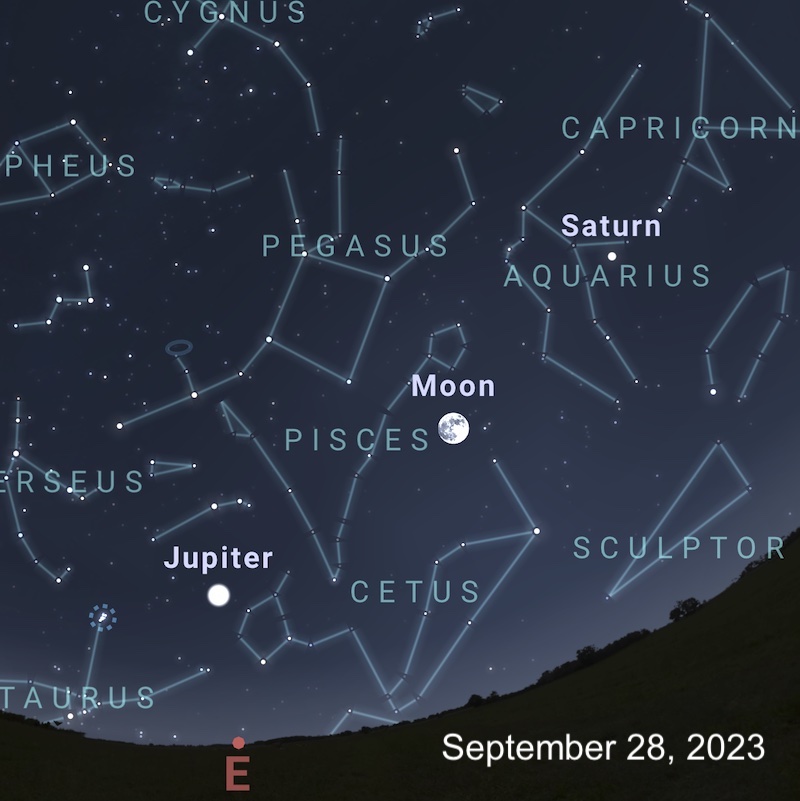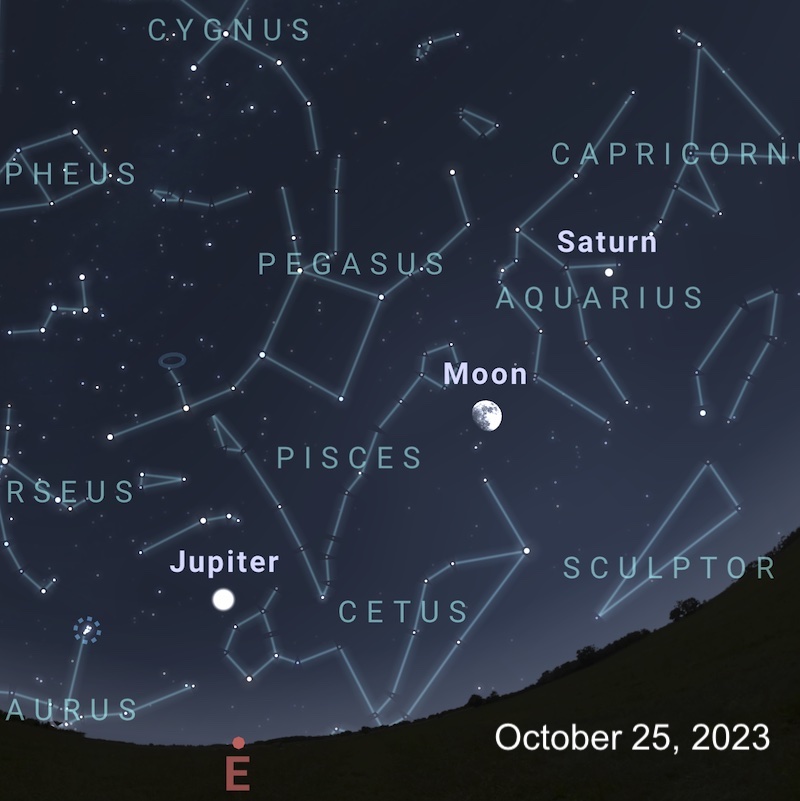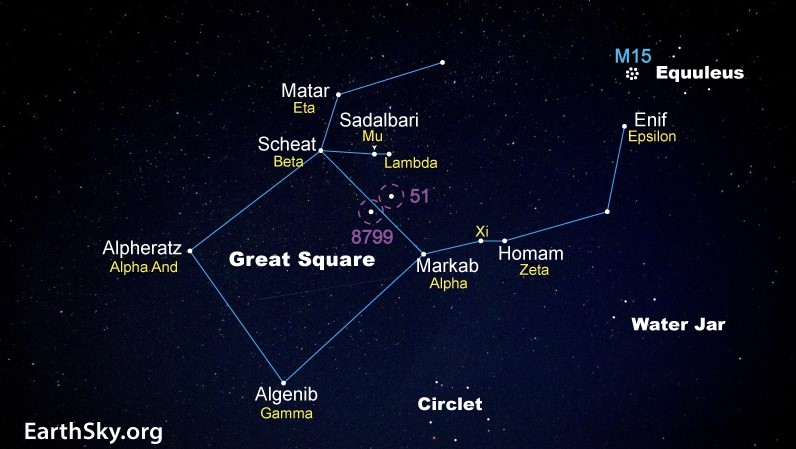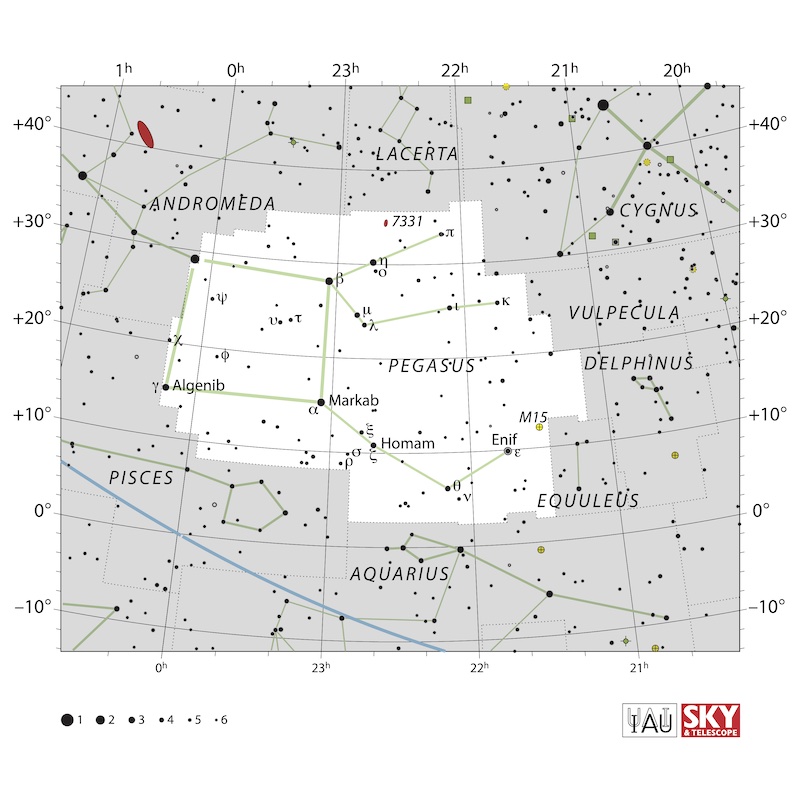Great Square of Pegasus
Look east just after dark for the Great Square of Pegasus around the time of the September equinox (in 2023, it was on September 23). Throughout late September and October evenings, the Great Square will be ascending in the eastern evening sky. The Great Square consists of four stars of nearly equal brightness. Specifically, they are Scheat, Alpheratz, Markab and Algenib. Incidentally, the constellation Pegasus represents a Flying Horse. But the Great Square – a prominent asterism within Pegasus – is a landmark of the Northern Hemisphere’s autumn sky.

To find the Great Square
First of all, to find the Great Square, use the Big Dipper to star-hop to Polaris, the North Star. Then draw an imaginary line from Polaris until you land an outer star on the W or M-shaped constellation Cassiopeia the Queen.
Finally, a line from Cassiopeia faithfully escorts you to the Great Square of Pegasus.

The moon can guide you to the Great Square
The moon will often be near the Great Square. Here are charts for late September and October 2023.


Also check EarthSky’s Visible planets and night sky guide for current information.
Great Square is an asterism, not a constellation
Like the Big Dipper, the Great Square of Pegasus isn’t a constellation. Instead, it’s an asterism, or noticeable pattern on our sky’s dome. And, like the Big Dipper, the Great Square can be used to help you find other sky treasures, the most notable being the Andromeda galaxy, another famous sight on autumn evenings in the Northern Hemisphere.
Read more: 2 ways to find the Andromeda galaxy

Great Square of Pegasus: A big square of nothing
Often, at events where many are stargazing for the first time, one may hear:
… the Great Square has nothing in it.
But, of course, the Great Square isn’t empty. In fact, no part of the night sky is really empty. But because the stars inside the Great Square are so faint, the unaided eye can’t easily detect them. However, if you use binoculars or a small telescope you can see many stars within the Great Square. Counting stars inside the Great Square is a good way to determine how dark your sky is when observing.
First discovery of an exoplanet orbiting a sun-like star
One of the most famous faint stars near the Great Square is 51 Pegasi. In 1995, astronomers announced in the journal Nature they’d discovered a planet around this star, and it is now called 51 Pegasi b. After a few months of skepticism from the astronomical community, it was confirmed that the first planet beyond our solar system had been discovered.
Now we know that at least 12 stars in Pegasus have exoplanets, and astronomers have confirmed more than 5,500 exoplanets in our Milky Way galaxy. The astronomers who found 51 Pegasi b – Michel Mayor of the University of Geneva and Didier Queloz at the Cavendish Laboratory and Geneva University – received the 2019 Nobel Prize in Physics for their discovery.
Some books say that 51 Pegasi is visible with the unaided eye alone. But it’s a challenge. Using binoculars, look roughly halfway between Scheat and Markab in the Great Square of Pegasus. Note that you won’t be able to see the planets. Pegasus 51 is approximately 50 light-years away from Earth.

Mythology of the Great Square of Pegasus
You might recall that Pegasus was a winged horse in Greek mythology. The constellation Pegasus is one of seven constellations in the autumn sky that explain why it’s never a good idea to claim a mortal’s beauty is greater than that of the gods. This story is plastered all over the autumn night sky, and Pegasus figures into it prominently.
The story goes that Cassiopeia the Queen bragged that she (or her daughter Andromeda the Princess) was more beautiful than the immortal Nereids, or sea nymphs. This angered the gods, who asked the sea-god Poseidon to take revenge. The punishment was that Cepheus the King and Cassiopeia had to sacrifice Andromeda to Cetus the Whale (sometimes called a sea monster). Andromeda was chained to a rock at sea. She was about to be gobbled up by Cetus, when she saw Perseus the Hero – riding Pegasus the Flying Horse – swooping toward her.
Perseus had a trick up his sleeve. He faced Cetus, holding up the head of the Gorgon Medusa. It’s said the sight of the Medusa turned Cetus to stone. Then Perseus whacked the chains that bound Andromeda and freed her. They rode off on Pegasus the Flying Horse and lived happily ever after. Later, Zeus placed all of them in the sky as stars, along with Delphinus the Dolphin, who’d provided comfort to Andromeda.

Bottom line: How you can see the Great Square of Pegasus star pattern.
Enjoying EarthSky so far? Sign up for our free daily newsletter today!











